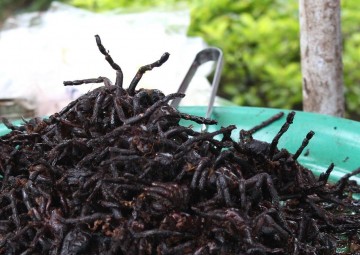The situation:
After you have emboldened yourself with dinners of stir-fried morning glories, amok fish and banana flower salads across Cambodia, you wish to roam off the menu and try the street treat that your Khmer friends keep wistfully mentioning: a-ping, or fried tarantula. But how?
The basics:
The fried tarantula is to Cambodians what a Devil Dog is to Americans—a sweet snack that kids beg their parents for. But while the Devil Dog is pumped full of high-fructose corn syrup and preservatives, the tarantula is a free-range burst of protein, clearly the responsible parent’s choice.
Tarantulas first started meeting with woks in large numbers during the tragically widespread food shortages of the brutal 1975-1979 Khmer Rouge regime. After the Khmer Rouge were ousted, Cambodians realized that their crafty survival skills had rewarded them with a tasty new chapter of gastronomy.
In addition to appreciating spiders for their nutrition, many Khmer women believe that eating a-ping makes one beautiful. The omnipresence of hair and beauty salons in the country, even in the smallest hamlets, demonstrates the Khmer’s interest in looking good, and many Khmer teens even forgo helmets while riding motorbikes to avoid the inevitable helmet hair. While scissors and gels remain popular with the well-coiffed, what better way to further cultivate one’s locks than to scarf down one of the hairiest creatures you can find?

Where to go:
While you can find a vendor or two hawking trays of a-ping in Kampong Thom and Phnom Penh alike, the town of Skuon—75 kilometers north of Phnom Penh—is the epicenter of a-ping cuisine, and close to the spiders’ underground burrows where they are harvested. If you are driving or taking a taxi, head to the town’s roundabout and roll down your window—a half-dozen vendors in Gilligan hats will rush their trays heaped with fried tarantulas to your door. What service! The buses that run between Kampong Thom and Phnom Penh make a regular stop in Skuon, at a restaurant about a half-kilometer from the roundabout, and you’ll likely find an a-ping vendor or two waiting right there .
How to eat:
You can eat them whole. But to start, pull off and eat the legs two or three at a time. Do this for a few reasons: The first is that you’ll notice the legs’ curious resemblance to the legs of its fellow arthropod, the soft-shell crab. With each crunch, you’ll also be able to better appreciate the flavor of the spider-monger’s perfected recipe: salt, sugar, oil, and garlic. And the most important reason for eating the legs first? Putting too much of the palm-sized creature into your mouth at the same time results in too many sharp, stiff legs jabbing at your gums from various directions; the spider seems alive—probably not the sensation you were looking for.

The crab comparison ends at the abdomen, where a mouthful of gooey nuttiness—followed by a musty, somewhat rude finish—awaits the snacker. It’s not quite an acquired taste; either you like it, or you will forever avoid it.
Whether you’re a leg muncher or a body chewer, you can rest assured that by enjoying a-ping, you not only give a nod to Cambodian craftiness, but you also support the livelihood of local vendors and spider catchers in a country where the average daily wage is under $2. And you just might get lots of compliments on your thick, healthy hair.
Source : World Hum


















